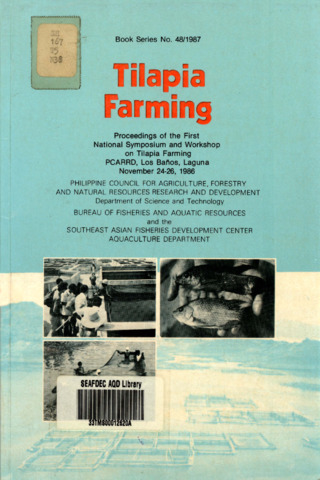Reproductive performance of four red tilapia strains in different seed production systems
- Global styles
- MLA
- Vancouver
- Elsevier - Harvard
- APA
- Help
Share
Abstract
Factors such as nutrition, season, sex ratio and broodstock density affect reproduction in red tilapias. However the extent by which genetic strain differences influence reproductive performance in red tilapias is not fully understood. Hence an experiment was conducted to compare the reproductive efficiency of three genetically diverse Philippine red tilapia strains (“BFS”, “FAC” and “PP’) and one imported Asian strain (“NIFI” from Bangkok, Thailand). Breeders (one male: four females) from each strain were tested in two types of fry production systems (2 m x 2 m x 1 m concrete tanks and lake based 2 m x 2 m x 1 m hapa net cages). Spawning activity, fecundity, and hatchability were monitored and recorded. Seed production in all strains were noted to be lower in cages than in tanks. Daily mean seed production per spawner in the land-based hatchery system was highest at 13.662 for NIFI followed by FAC ( 13.236), BFS (10.966), and PF (7.77). In the hapa net cages, the BFS strain produced 1.137 seeds per female daily while PF, NIFI and FAC gave daily harvests of 0.968, 0.773 and 0.517 seeds per spawner. Seed production was significantly influenced by the type of hatchery system (P = 0,000) , strain (P = 0,021) and strain x hatchery system (P = 0,007), No significant strain differences were found when spawning percentage and hatchability data were analysed.
Description
Abstract only.
Suggested Citation
Romana-Eguia, M. R. R., & Eguia, R. V. (1995). Reproductive performance of four red tilapia strains in different seed production systems. Aquaculture , 137(1-4), 328. https://doi.org/10.1016/0044-8486(96)83586-1
Type
ArticleISSN
0044-8486Koleksi
- Journal Articles [1256]
Related items
Showing items related by title, author, creator and subject.
-
Antibacterial activity of tilapia Tilapia hornorum against Vibrio harveyi
Tendencia, Eleonor ; dela Peña, Milagros R.; Fermin, Armando C.; Lio-Po, Gilda; Choresca, Casiano H., Jr.; Inui, Yasuo (Elsevier, 2004)
Disease due to luminous Vibrio has been a major problem of the shrimp industry. Different technologies have been introduced to control the disease. One of the techniques reported to work against luminous bacteria in the ...
; dela Peña, Milagros R.; Fermin, Armando C.; Lio-Po, Gilda; Choresca, Casiano H., Jr.; Inui, Yasuo (Elsevier, 2004)
Disease due to luminous Vibrio has been a major problem of the shrimp industry. Different technologies have been introduced to control the disease. One of the techniques reported to work against luminous bacteria in the ... -
An investigation of enzyme and other protein polymorphisms in Japanese stocks of the tilapias Oreochromis niloticus and Tilapia zillii
Basiao, Zubaida U.; Taniguchi, Nobuhiko (Elsevier, 1984)Samples of Oreochromis niloticus and Tilapia zillii were collected from the hatcheries of Osaka Prefecture Fisheries Experimental Station and Shiga Prefecture Fisheries Experimental Station, Japan, respectively. The samples ... -
Tilapia Farming: Proceedings of the First National Symposium and Workshop on Tilapia Farming, PCARRD, Los Baños, Laguna, November 24-26, 1986
Guerrero III, Rafael D.; de Guzman, Dalisay L.; Lantican, Cecilia M. (Philippine Council for Agriculture, Forestry and Natural Resources Research and Development, 1987)





